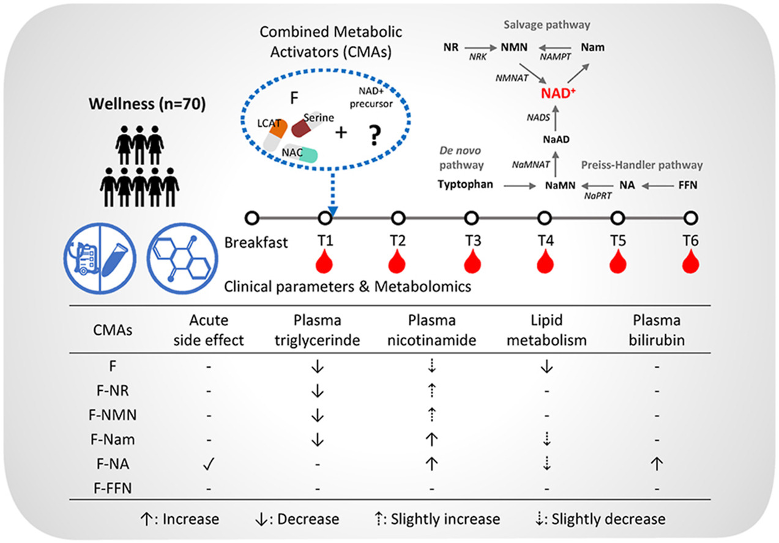Key Points:
- Nicotinamide mononucleotide (NMN), nicotinamide riboside (NR), nicotinamide (Nam), nicotinic acid (NA), and flush-free NA (FFN) were each tested for their metabolic effects when combined with L-serine, N-acetyl cysteine (NAC) and L-carnitine tartrate (LCAT) — the combined metabolic activator (CMA).
- The CMA with NMN, NR, or Nam similarly reduced blood fat (triglyceride) levels in healthy adults.
- In order of speed, Nam, NA, NMN, and NR raised NAD+ breakdown products — a measure of NAD+ levels.
The original CMA was designed to restore NAD+ levels, promote fat metabolism, reduce inflammation, and increase glutathione — our most powerful natural antioxidant. Initially including NR, the CMA was previously shown to help treat non-alcoholic fatty liver disease and Alzheimer’s disease patients. Now, researchers based in the United States, Sweden, China, Turkey, Denmark, and England have tested the effects of other NAD+ precursors in this antioxidant and fat-metabolizing blend.
As reported in Free Radical Biology and Medicine, Li and colleagues find that switching NR with NMN in the CMA formulation leads to similar effects after one day of administration. They show that NMN, NR, and Nam similarly reduce blood fat levels. Furthermore, each precursor (except for FFN) raises NAD+ byproducts, albeit to different degrees. Additionally, NMN and NR perturb fat metabolism the least, while NAM and NA reduce important fats.

To begin, 70 healthy subjects (18 to 47 years old) were divided into groups of 10 and randomly assigned to receive a placebo or one of the six CMAs. The CMA formulation without an NAD+ precursor (F) contains 12.35 g L-serine, 3.73 g LCAT, and 2.55 g NAC. Serine is a source of glycine which together with cysteine drives the synthesis of glutathione. Carnitine (LCAT) is required for transporting fatty acids into mitochondria for energy production. One gram of one of the five different NAD+ precursors were added to the CMA (F-NR, F-NMN, F-Nam, F-NA, and F-FFN.
After having identical breakfasts at 8:00 am, blood samples were collected from the participants at 9:00 am (T1) followed by oral intake of their CMA or placebo. Blood samples were again taken at 10:00 am (T2), 11:00 am (T3), 12:00 pm (T4), 3:00 pm (T5), and 4:30 pm (T6). Flushing was observed in all 10 subjects from the F-NA group, encompassing skin redness, burning, and itching. Otherwise, each formulation was considered safe and without side effects.
The blood samples were used to make all measurements, including blood fat levels. It was found that the F, F-NR, F-NMN, and F-Nam groups had lower blood fat levels at T6 compared to T1. Of note, the F-NR group also showed reduced blood glucose levels. Nonetheless, blood glucose and fat levels remained within the average range. These findings suggest that CMA, even without an NAD+ precursor can elevate fat metabolism, perhaps due to carnitine.

To examine NAD+ levels, Li and colleagues measured metabolites associated with the three NAD+ synthesis pathways (shown in the study summary figure). The F-Nam and F-NA groups showed the fastest and highest increase in NAD+ breakdown products, including Nam. Furthermore, the F-NMN group showed a faster increase in nicotinamide (at T4) compared to F-NR (at T6), suggesting that NMN is metabolized to NAD+ faster than NR. This could be because NMN is directly converted to NAD+, whereas NR takes an extra step to be converted.
The other NAD+ precursors tested either depleted or had no effect on NAD+ byproducts. With the F group, there was a depletion of nicotinamide and no effect on the other byproducts, suggesting that an NAD+ precursor is needed in the CMA formulation to maintain NAD+ levels. With the F-FFN group, there was no effect on any byproducts, suggesting that FFN does not acutely boost NAD+ levels. This is likely because FFN is designed for slow release as to prevent flushing.

To further examine the effect of different NAD+ precursors in the CMA, Li and colleagues compared which metabolites were either increased or decreased between groups. It was found that the F and F-NA groups had the highest number of perturbations in metabolites. From these findings, it can be assumed that, with more differences in metabolites, there is a higher likelihood of potential imbalances.

To investigate the potential consequences of the above metabolite differences, Li and colleagues mapped each metabolite to its cellular pathway. From this, the researchers observed reduced phospholipid-related metabolites in the F, F-Nam, and F-NA groups. Phospholipids are the primary component of cellular membranes. Therefore, a reduction in these important fat molecules could compromise cellular function and potentially lead to disease. That being said, in the NA group, there was an increase in bilirubin metabolites, which are markers of liver disease.
Overall, the findings of Li and colleagues suggest that both NMN and NR have similar acute effects on select metabolic measurements when combined the CMA in healthy adults. Whether these similarities remain after one day is unknown and requires further testing. Importantly, blood NAD+ levels were not directly measured, but it can be deduced that NMN and NR raise NAD+ levels similarly. Further studies are needed to compare the effects of these NAD+ precursors with the CMA on organ NAD+ levels.
NMN vs NR
NMN and NR are the two most popular and well-studied NAD+ precursors. Both have been shown to raise NAD+ levels and ameliorate features of aging and disease in animal models and humans. However, it is difficult to determine which is better without comparing the two directly under the same experimental conditions, like in this study.
Animal studies have also directly compared NMN to NR under the same conditions. One study showed that Nam, NR, and NMN similarly improve skin regrowth. Another study showed NMN and NR similarly inhibit the release of inflammatory molecules from immune cells. Both NMN and NR also similarly restore age-related lubricant-secreting eye gland atrophy. Therefore, based on these studies, it would seem that both NMN and NR have similar effects on multiple conditions.